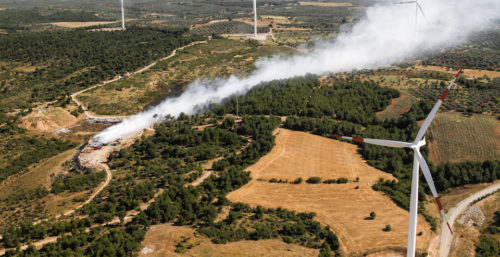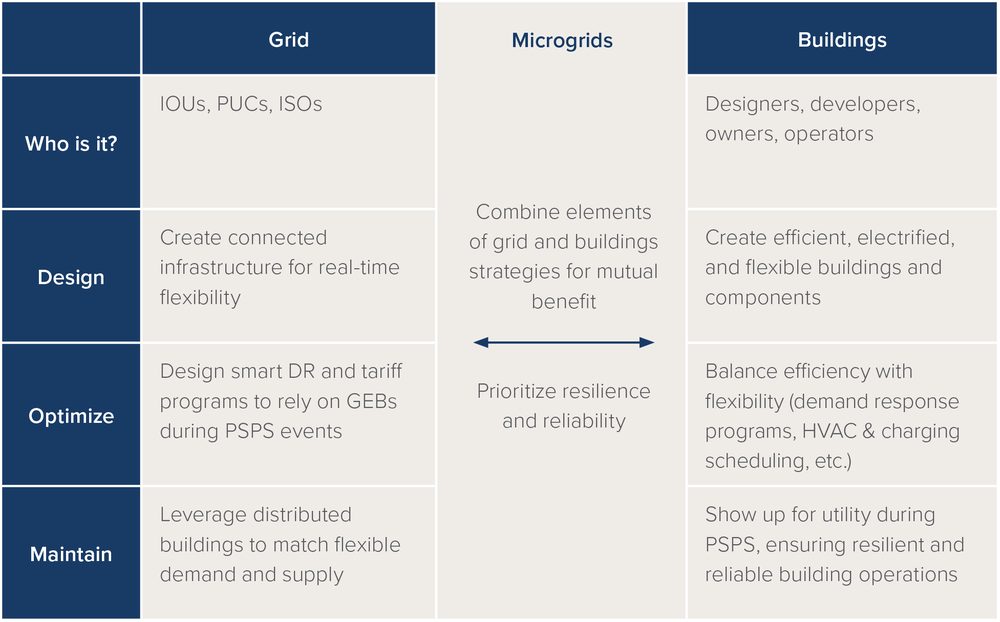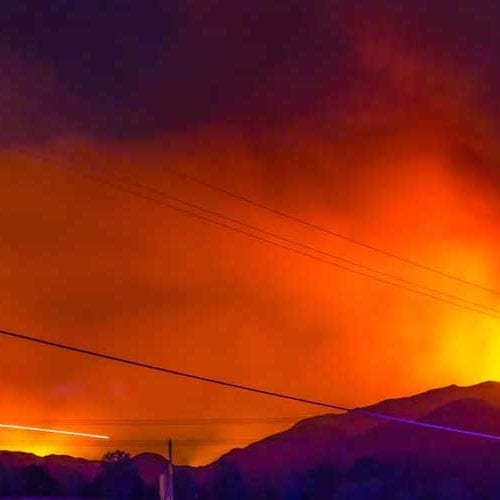Fire where Near to Wind Turbine

Mitigating the Impacts of Power Shutoffs through Building–Grid Integration
During the California wildfire season this past year, utility companies had to shut off power to tens of thousands of residents in an attempt to prevent wildfires. These Public Safety Power Shutoffs (PSPS) help keep communities safe but can be very disruptive to everyday life. Utilities are not always able to safely energize delivery circuits during PSPS events, which can sometimes lead to power cuts for more than two days. Grid-interactive efficient buildings (GEBs) can play a critical role in mitigating the impact of PSPS for both buildings and the grid. GEBs are able to flex their demand, contributing to grid resilience during these events.
Utilities in California and other Western states are working to reduce the frequency, scope, and severity of wildfire-related PSPS events. This task is made more difficult by shifting load patterns such as increased electrification (of both vehicles and buildings) and higher temperatures. These shifting patterns will not only increase aggregate load but also drive up spikiness, making it even more difficult to manage.
In order to decrease PSPS events, we will need more GEBs. Relative to today’s most common PSPS mitigation toolーdistributed diesel generators, which come with local particulate emissions issues and logistical challengesーGEBs are relatively untapped resources. In fact, GEBs have the potential to reduce the capacity that needs to be procured in the first place.
As the next fire season approaches on the West Coast, we need to accelerate investment in GEBs today. This is a moment that is ripe for collaboration between buildings and the grid. Below, we list actions to help both buildings and the grid enable GEBs to mitigate the impacts of PSPS events.
Exhibit 1: The critical roles that both buildings and stakeholders play in all phases of GEB development, and the importance of collaboration.
Ideal GEB Features for PSPS
Energy Efficiency and Flatter Demand Curves
The lowest-hanging fruit is usually energy efficiency upgrades.
- Buildings—The most obvious step is to weatherize older homes and commercial buildings. More advanced measures focus on peak demand reduction. Targeted operating modificationsーsuch as the pre-cooling of buildingsーcan reduce not only annual demand charges but also the maximum capacity utilities need to procure at substations during PSPS.
- The grid—Adopt programs that incentivize efficiency improvements, especially those related to HVAC. Such programs are an easy win-win for both parties because they can minimize load peakiness and reduce base load.
Connectivity Between Buildings and the Grid
While two-way communication between buildings and the grid will be critical to effectively leverage GEBs for PSPS mitigation, technology advancement in distributed energy resource management systems will be required to fully unlock this potential. Nonetheless, anything that can be done today to curtail noncritical loads will reduce the amount of generation required by the utility at or near substations in load pockets (areas that require local generation due to insufficient capacity in the transmission system) that are safe to energize.
- Buildings—Design control systems that can receive signals from the grid. This would allow buildings to respond to grid needs by pre-charging batteries, precooling spaces, preheating water, and notifying tenants so that they can schedule energy-consuming activities like cooking, laundry, and device charging around the signal.
- The grid—Provide a signal of PSPS events and other grid needs to buildings and leverage demand response (DR) and other existing programs to flex demand based on the time varying needs of the grid. Leveraging these programs could mean increasing incentive payments.
Underground or Hardened Infrastructure
Underground or “hardened” infrastructure can add expense to any microgrid development but can allow a microgrid to operate even if the rest of the load pocket is not safe to energize due to wildfire ignition risk.
- Buildings and any microgrid equipment that they can operate—Protect infrastructure to minimize fire risk. The best-case scenario would be to underground connective lines but other system hardening measures could include covered conductors and fire-resistant poles.
- The grid and any microgrid equipment that utilities operate—Protect infrastructure to ensure power delivery, minimize fire risk, and protect connected infrastructure from downstream fault-related damages.
Energy Supply Diversity
When PSPS events are coincident with nearby wildfires, ash and low solar irradiance can drastically reduce output of solar panels. As such, energy supply diversity during PSPS can be paramount for building and grid stakeholders alike.
- Buildings—Install solar panels in combination with additional generation sources such as fuel cells or linear generators for added resilience in fire season.
- The grid—Diversify energy sources so that no single source is too essential. Distributed energy resources can be more valuable when steady and predictable. Of course, this is even more challenging to accomplish at the distribution level alone when the transmission system is inoperable.
Ability to Withstand Multiday Events
Microgrids should optimally withstand multiday outages (at least 48 hours) through sufficient balancing of generation and load control, efficiency measures, and curtailment of non-critical loads.
- Buildings—Build out customer-sited energy resources that can withstand the length of a PSPS. While this can be achieved through oversizing, a more attractive option may be to focus first on the demand side (i.e., the curtailment of non-critical loads).
- The grid—Overbuild customer microgrids so they can support the distribution grid during an emergency. While oversizing generation can allow buildings to better support the grid and withstand longer-duration PSPS events, current net energy metering pricing does not incentivize that decision.
Connected Communities
Community microgrids can be more complex due to multiparty agreements and regulatory issues that prevent microgrids from crossing a right-of-way to distribute electricity. Nonetheless, this complexity can be worth navigating if it can enable partial or full continuity of operations during an outage or critical emergency.
- Buildings—Establish multisite microgrids by grouping residential, commercial, and industrial buildings with dissimilar load profiles, hence flattening demand.
- The grid—Develop multi-customer microgrids, like the Redwood Coast Airport Microgrid, that can export power and provide grid services in combination with resilience for customers.
Paying for It
For buildings, proactivity is key. Building owners located in high fire-threat districts can invest in their own resilience and become “prosumers” in advance of need.
For homeowners that are interested in contributing to the grid’s flexibility needs:
- When upgrading appliances, get an efficient one! You may qualify for rebates (e.g., PG&E’s rebate program).
- Consider adding a home battery and qualifying for the Self Generation Incentive Program (SGIP) (SGIP funds were recently reallocated to low-income, PSPS-affected areas).
- Members of community choice aggregation programs may qualify for additional incentives (e.g., EBCE’s Resilient Home Program, Marin Clean Energy Battery Program).
For businesses/commercial building owners to contribute:
- Consult your utility for already available programs and resources for energy management, such as PG&E’s Business Energy Checkup.
- Invest in advanced controls and monitoring to better understand your energy consumption to be able to manage it appropriately during PSPS events.
- Consider joining an existing DR program if you have not already (see PG&E’s here).
For the grid, investor-owned utilities and public utility commissions (PUCs) should build on FERC Order 2222 and include mechanisms for customers to provide grid support and be compensated accordingly during outages or during heat-related emergencies.
Potential sources of value from customer microgrids:
- For utilities like PG&E that are looking to energize load pockets during PSPS, overbuilt microgrids that can both over-produce during PSPS and curtail non-critical loads could reduce the need for generation at the substation (see ADL’s techno-economic analysis of clean alternatives to diesel for PSPS mitigation).
- Black start capability can help the load pocket instantaneously energize when transmission is de-energized (requires additional communication and control with the microgrid).
- Groups of buildings with dissimilar load profiles could be better controlled to flatten demand, reducing the capacity that needs to be procured at the substation.
Other general opportunities for utilities or a PUC to consider:
- Capacity-based DR programs like PG&E’s Base Interruptible Program could expand to include PSPS response and support.
- An additional kWh “adder” or rebate could incentivize customers to transition to smart, connected appliances.
- Residential thermostat programs (e.g., SmartAC program) and third-party flexible load programs like OhmConnect or EnergyHub could be expanded and brought to new utility territories.
In general, there are many movements to advance GEB-enabling technologies, platforms, and programs. Recent funding initiatives like the California Flexible Load Research and Deployment Hub and the DOE Connected Communities FOA are prime examples.
PSPS events are just one acute example of the necessity of grid and building collaboration. Even though most of these events occur in California, the increasing wildfire threat in Oregon, Colorado, and other Western states will expand the necessity of these events. The ideas presented here are not comprehensive but are intended to spur thinking on how utilities and customers can collaborate to design, optimize, and maintain resilient grid-integrated resources.
Many more programs can be developed. One thing that is clear is that more collaboration between buildings and the grid will create resilient, connected communities.


